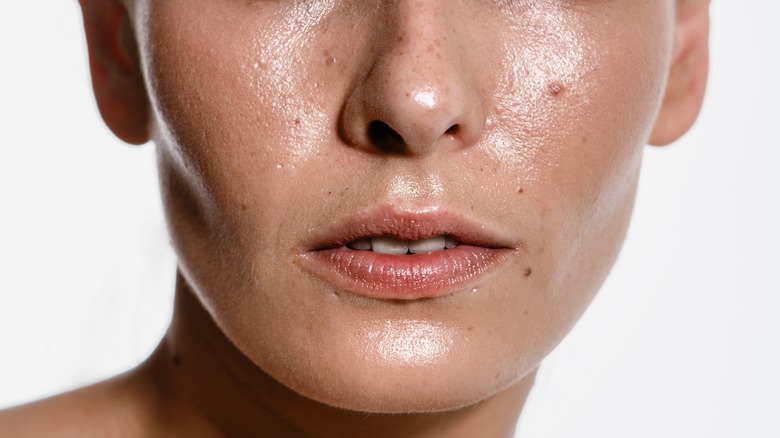The Best Ways To Balance Your Sebum Production
According to the American Academy of Dermatology Association, acne is the most common skin condition in the U.S. Though it's often associated with puberty and teenage hormone changes, acne affects adults, too. Women are more likely to struggle with acne than men, with 50% of women in their 20s and 25% of women in their 40s experiencing some breakouts (per Healthline).
Often, at the root of acne breakouts is an imbalance of sebum production. MedicalNewsToday explains that sebum is a fatty oil produced by the skin's sebaceous glands, bringing moisture and antioxidants to the skin's outer layers. Though it plays an important role in protecting the skin, too much of it can clog pores, leading to acne. A tell-tale sign of excess sebum (besides blemishes) is shiny, oily skin and enlarged pores.
On the other end of the skin spectrum is dry skin, where acne breakouts aren't so common, but flaky skin and itchiness are more prominent. Those who struggle with dry skin, too, typically have an imbalance of sebum production. Unlike oily skin — where there's too much sebum — dry skin can be caused by too little sebum. While you can't turn a dial up or down on your skin's sebum levels, there are ways to balance sebum production to create a clearer, smoother complexion.
How to control sebum overproduction
If your skin is producing too much sebum, making simple lifestyle changes can be an easy first step to getting oil under control. A 2016 study published in Advances in Dermatology and Allergology suggests that dairy and foods with a high glycemic index (such as white bread and sweets) trigger sebum production, causing acne flare-ups. Replacing these foods with whole grains, fiber-rich vegetables, and protein may help slow sebum production.
Managing stress can also help oily skin. As MindBodyGreen explains, stress triggers the hormone cortisol, which activates sebum production. Dealing with stress in healthy ways — such as by exercising, meditating, or speaking with a therapist — could help keep sebum at bay.
When lifestyle improvements fail, Healthline suggests turning to medication. Combination birth control pills (containing both estrogen and progestin) can be used to reduce sebum in women, while isotretinoin may be recommended for severe acne breakouts.
How to increase sebum in dry skin
For those struggling with dry skin, a lack of sebum may be the culprit. To balance an underproduction of oil, Verywell Health suggests surveying the contents of your medicine cabinet. Unsurprisingly, the same medications that can help control the overproduction of sebum may also lead to an underproduction. Oral contraceptives, retinoids (including oral medications like isotretinoin, as well as topical solutions), and acne medications can sometimes be too harsh on the skin. Replacing these medications with other doctor-approved treatments may help rebalance sebum production. A doctor can also prescribe testosterone therapy for those who are low on the hormone and experiencing a lack of sebum as a result (per Healthline).
Similar to sebum overproduction, underproduction can also be influenced by diet. A 2013 study published in Clinics in Dermatology found that severely restricting calories impedes sebum production. Following a balanced diet and increasing the consumption of water and omega-3 fatty acids — found in foods like fish and nuts — may boost sebum in parched skin.



